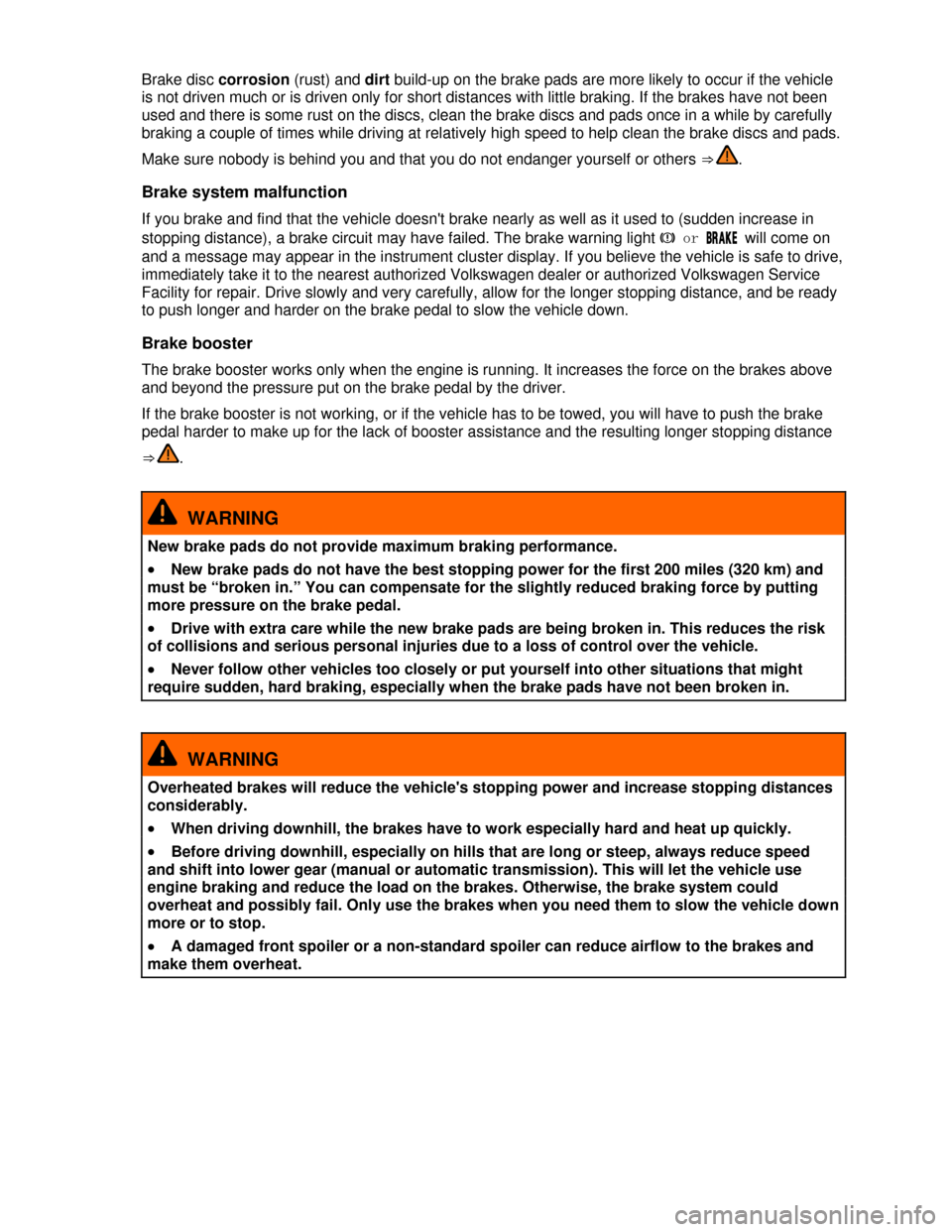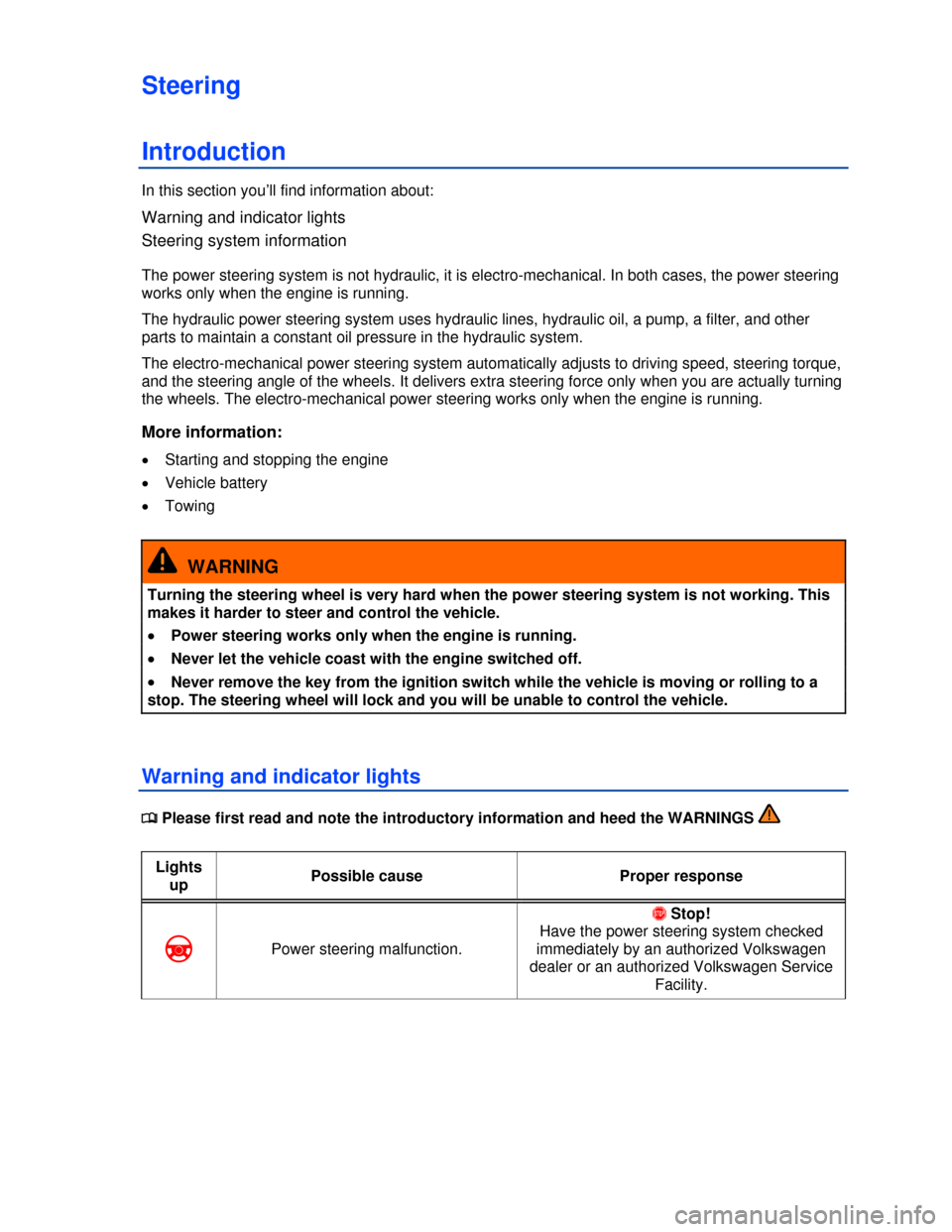oil pressure VOLKSWAGEN GOLF GTI 2013 5G / 7.G Owners Manual
[x] Cancel search | Manufacturer: VOLKSWAGEN, Model Year: 2013, Model line: GOLF GTI, Model: VOLKSWAGEN GOLF GTI 2013 5G / 7.GPages: 319, PDF Size: 5.18 MB
Page 114 of 319

Brake disc corrosion (rust) and dirt build-up on the brake pads are more likely to occur if the vehicle
is not driven much or is driven only for short distances with little braking. If the brakes have not been
used and there is some rust on the discs, clean the brake discs and pads once in a while by carefully
braking a couple of times while driving at relatively high speed to help clean the brake discs and pads.
Make sure nobody is behind you and that you do not endanger yourself or others ⇒ .
Brake system malfunction
If you brake and find that the vehicle doesn't brake nearly as well as it used to (sudden increase in
stopping distance), a brake circuit may have failed. The brake warning light �H or �"�2�!�+�% will come on
and a message may appear in the instrument cluster display. If you believe the vehicle is safe to drive,
immediately take it to the nearest authorized Volkswagen dealer or authorized Volkswagen Service
Facility for repair. Drive slowly and very carefully, allow for the longer stopping distance, and be ready
to push longer and harder on the brake pedal to slow the vehicle down.
Brake booster
The brake booster works only when the engine is running. It increases the force on the brakes above
and beyond the pressure put on the brake pedal by the driver.
If the brake booster is not working, or if the vehicle has to be towed, you will have to push the brake
pedal harder to make up for the lack of booster assistance and the resulting longer stopping distance
⇒ .
WARNING
New brake pads do not provide maximum braking performance.
�x New brake pads do not have the best stopping power for the first 200 miles (320 km) and
must be “broken in.” You can compensate for the slightly reduced braking force by putting
more pressure on the brake pedal.
�x Drive with extra care while the new brake pads are being broken in. This reduces the risk
of collisions and serious personal injuries due to a loss of control over the vehicle.
�x Never follow other vehicles too closely or put yourself into other situations that might
require sudden, hard braking, especially when the brake pads have not been broken in.
WARNING
Overheated brakes will reduce the vehicle's stopping power and increase stopping distances
considerably.
�x When driving downhill, the brakes have to work especially hard and heat up quickly.
�x Before driving downhill, especially on hills that are long or steep, always reduce speed
and shift into lower gear (manual or automatic transmission). This will let the vehicle use
engine braking and reduce the load on the brakes. Otherwise, the brake system could
overheat and possibly fail. Only use the brakes when you need them to slow the vehicle down
more or to stop.
�x A damaged front spoiler or a non-standard spoiler can reduce airflow to the brakes and
make them overheat.
Page 191 of 319

Steering
Introduction
In this section you’ll find information about:
Warning and indicator lights
Steering system information
The power steering system is not hydraulic, it is electro-mechanical. In both cases, the power steering
works only when the engine is running.
The hydraulic power steering system uses hydraulic lines, hydraulic oil, a pump, a filter, and other
parts to maintain a constant oil pressure in the hydraulic system.
The electro-mechanical power steering system automatically adjusts to driving speed, steering torque,
and the steering angle of the wheels. It delivers extra steering force only when you are actually turning
the wheels. The electro-mechanical power steering works only when the engine is running.
More information:
�x Starting and stopping the engine
�x Vehicle battery
�x Towing
WARNING
Turning the steering wheel is very hard when the power steering system is not working. This
makes it harder to steer and control the vehicle.
�x Power steering works only when the engine is running.
�x Never let the vehicle coast with the engine switched off.
�x Never remove the key from the ignition switch while the vehicle is moving or rolling to a
stop. The steering wheel will lock and you will be unable to control the vehicle.
Warning and indicator lights
�
Page 221 of 319

Checklist
If you are uncertain in any way, have the work done by an authorized Volkswagen dealer or
authorized Volkswagen Service Facility. Serious personal injury may result from improperly performed
work. Make sure that you check the following items regularly. The best thing is to check them every
time you refuel:
�d Windshield washer fluid level
�d Engine oil level
�d Engine coolant level
�d Brake fluid level
�d Tire pressure
�d Vehicle lighting necessary for driving safety:
– Turn signals
– Low beams and high beams
– Taillights
– Brake lights
– License plate lights
Information regarding changing light bulbs
WARNING
Disregarding the safety-related checklist may lead to accidents and injuries.
�x Please note and follow the points listed in the checklist.
Page 264 of 319

Cold tire inflation pressure
The tire pressure recommended by the vehicle manufacturer for a tire of a specified size that has not
been driven for more than a couple of miles (kilometers) at low speeds in the 3 hour period before the
tire pressure is measured or adjusted.
Curb weight
The weight of a motor vehicle with standard equipment including the maximum capacity of fuel, oil,
and coolant, air conditioner, and additional weight of optional equipment.
Extra load tire
A tire designed to operate at higher loads and at higher inflation pressures than the corresponding
standard tire.
Gross Axle Weight Rating (GAWR)
The load-carrying capacity of a single axle system, measured where the tire contacts the ground.
Gross Vehicle Weight Rating (GVWR)
The maximum loaded weight of the vehicle.
Groove
The space between 2 adjacent tread ribs.
Load rating (code)
The maximum load that a tire is rated to carry for a given inflation pressure. You may not find this
information on all tires because it is not required by law.
Maximum load rating
The load rating for a tire at the maximum permissible inflation pressure for that tire.
Maximum loaded vehicle weight
The total of:
�x Curb weight.
�x Accessory weight.
�x Vehicle capacity weight.
�x Production options weight.
Maximum (permissible) inflation pressure
The maximum cold inflation pressure to which a tire may be inflated. Also called “maximum inflation
pressure.”
Normal occupant weight
Means 150 lbs (68 kilograms) times the number of occupants seated in the vehicle up to the total
seating capacity of your vehicle.
Occupant distribution
The placement of passengers in a vehicle.
Outer diameter
The diameter of a new, properly inflated tire.
Overall width
Total width measured at the exterior sidewalls of an inflated tire, including the additional width of
labeling, decorations, or protective bands or ribs.
Page 269 of 319

Parts, accessories, repairs and modifications
Introduction
In this section you’ll find information about:
Break-in period
Parts and accessories
Operating fluids and equipment
Repairs and technical modifications
Repairs and other things that can affect Advanced Airbag performance
Repairs and other things that can affect Airbag performance
CB radio equipment
Notice about data recorded by vehicle control modules
Using a mobile phone in a motor vehicle when it is not connected to the vehicle telephone
antenna - some important things to know
Lift points for the vehicle
More information:
�x Safety belts
�x Airbag system
�x Roof rack
�x Trailer towing
�x 12 Volt sockets
�x Braking, stopping and parking
�x Starting assistance systems
�x Cruise control system (CCS)
�x Tire Pressure Monitoring System (TPMS)
�x Preparations for working in the engine compartment
�x Engine oil
�x Engine coolant
�x Vehicle battery
�x Exterior care and cleaning
�x Interior care and cleaning
�x Consumer information
�x ⇒ Booklet Radio
�x ⇒ Booklet Navigation system
�x ⇒ Booklet Mobile Phone Package